This topic describes how to view and modify the migration objects specified by using the Specify Objects option of a data migration task as well as their SQL filter conditions by using the data transmission service.
Background
You can add or remove migration objects and modify their filter conditions during migration under the specified limitations. The changes made are recorded. When an object modification task is completed, it is integrated with the associated original task. When the integration is completed, the original task runs normally and the object modification task is automatically released.
For information about how to modify the migration objects specified by using the Match Rules option of a data migration task as well as their SQL filter conditions, see Configure and modify matching rules.
Limitations
For a data migration task whose migration objects are selected only by using the Specify Objects option, you can modify its migration objects.
For a data migration task in the Not Started, Running, or Paused state, you can add or remove its migration objects.
ImportantFor a data migration task in the Paused state, if the Full Migration or Incremental Synchronization step of the task is also in the Paused state, you cannot add its migration objects.
For a data migration task in the Failed state, you cannot add its migration objects.
For a data migration task in the Modifying or Integrating state, you cannot modify its migration objects again.
When the Full Migration or Incremental Synchronization step of a data migration task is in the Paused or Failed state, you cannot add its migration objects.
In the Reverse Increment step of a data migration task, you cannot add its migration objects.
When you migrate data from a PolarDB-O database to an Oracle tenant of OceanBase Database, you cannot add migration objects.
When you migrate data from a Lindorm or HBase database to OBKV, you cannot add migration objects or modify row filter conditions.
For a data migration task in the Paused, Failed, Not Started, or Running state, you can modify its row filter conditions.
View migration objects
Log on to the ApsaraDB for OceanBase console.
In the left-side navigation pane, choose Data Transmission > Data Migration.
On the Migrate Data page, click the name of the target task to go to its details page.
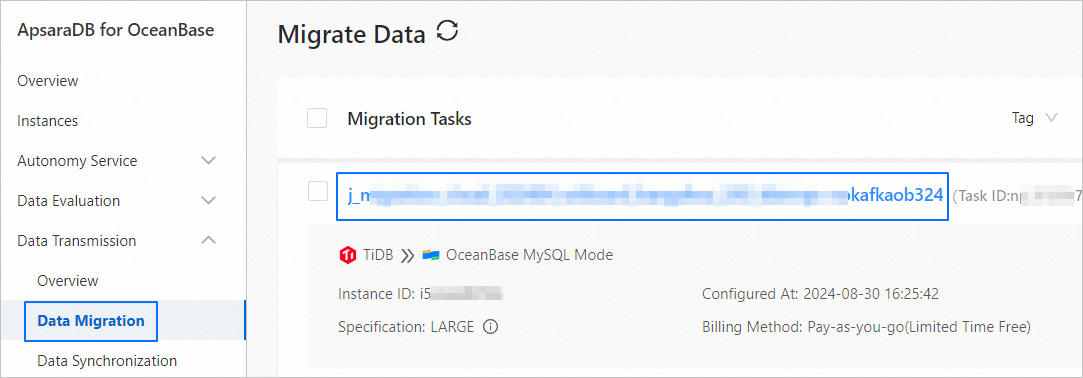
Click View Objects in the upper-right corner and view information on the Migration Scope and Object Modifications tabs.
The Migration Scope tab displays the migration objects of the current task. You can click Add Objects or Remove Objects to add or remove objects and modify their row filter conditions.
The Object Modifications tab displays the types, status, and occurrence time of all object modifications.
Add migration objects
On the details page of the target task, click View Objects in the upper-right corner.

In the View Objects dialog box, choose Synchronization Objects > Add Objects.
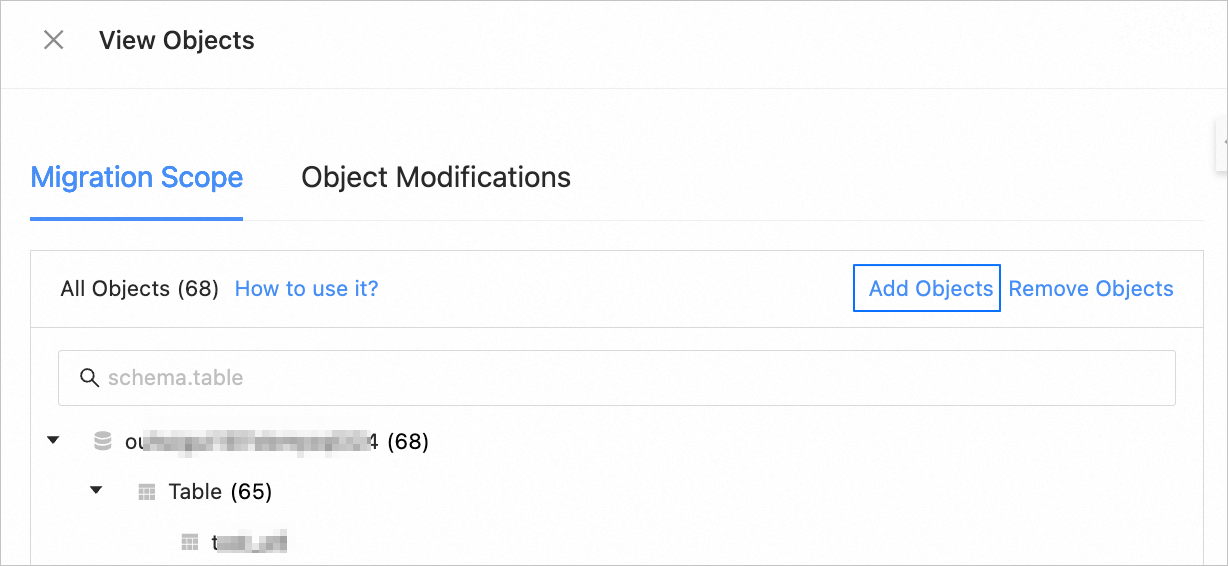
In the Add Object dialog box, select migration objects in the left-side Source Object section and click > to add them to the right-side list. You can select tables and views of one or more databases as the migration objects.

After you select the migration objects to add, you can perform operations such as renaming objects, setting row filters, viewing column information, and removing objects.
 Important
ImportantBy default, the newly added migration objects inherit all configuration options of the original data migration task. If you abort the object addition operation, you must manually delete the objects that have been added to the target database.
If you specified the schema name or DB name for the source data source, you can add only the migration objects under the specified schema name or database name.
Click Next.
The system automatically performs a precheck on the added migration objects. After the added synchronization objects pass all check items, click Save.
Confirm the information and click OK in the dialog box that appears.
For a paused or failed data synchronization task, you can cancel the operation and modify the synchronization objects again. The added migration objects will be migrated to the target database only after the data migration task returns to normal.
If you add migration objects for a running data migration task, after you click Save, the added migration objects are immediately migrated to the target database.
When an object addition operation begins, the corresponding record is generated. To view the details of the record, click View Objects on the details page of the task and then click the Object Modifications tab.
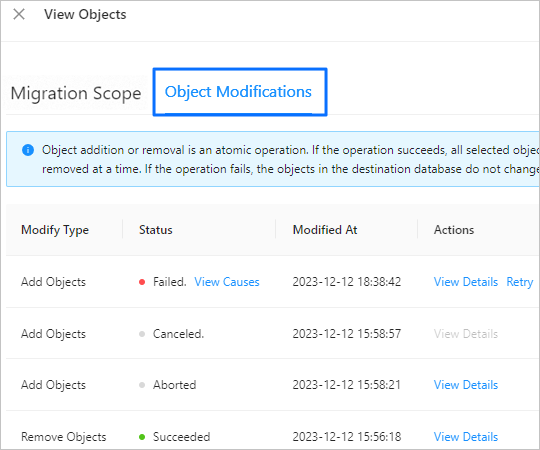
The status of an object addition record can be Pending, Canceled, Modifying, Running, Aborted, Integrating, Succeeded, or Failed. The operations that you can perform on an object addition record and the status of the original data synchronization task vary with the status of the object addition record.
NoteIf the original data synchronization task is in the Not Started state, a modification record in the Succeeded state is generated for an object addition operation. If the original data synchronization task is in the Paused state, a modification record in the Pending state is generated for an object addition operation.
The status of an object addition record changes only when the original data synchronization task is in the Running state, and the status of the original task changes along with the status of the object addition record. The following table describes more information.
Status of an object addition record
Supported operations
Status of the original task
Pending
View details and cancel the addition.
Running
Canceled
None
Running
Modifying
None
Modifying
Running
View details and abort the addition.
Modifying
Aborted
View details.
Running
Integrating
View details.
Integrating
Succeeded
View details.
Running
Failed
View details and retry the addition.
You can also click View Causes to go to the task details page and view the failure causes.
Modifying or Integrating
Remove migration objects
On the details page of the target task, click View Objects in the upper-right corner.

In the View Objects dialog box, choose Migration Scope > Remove Objects.
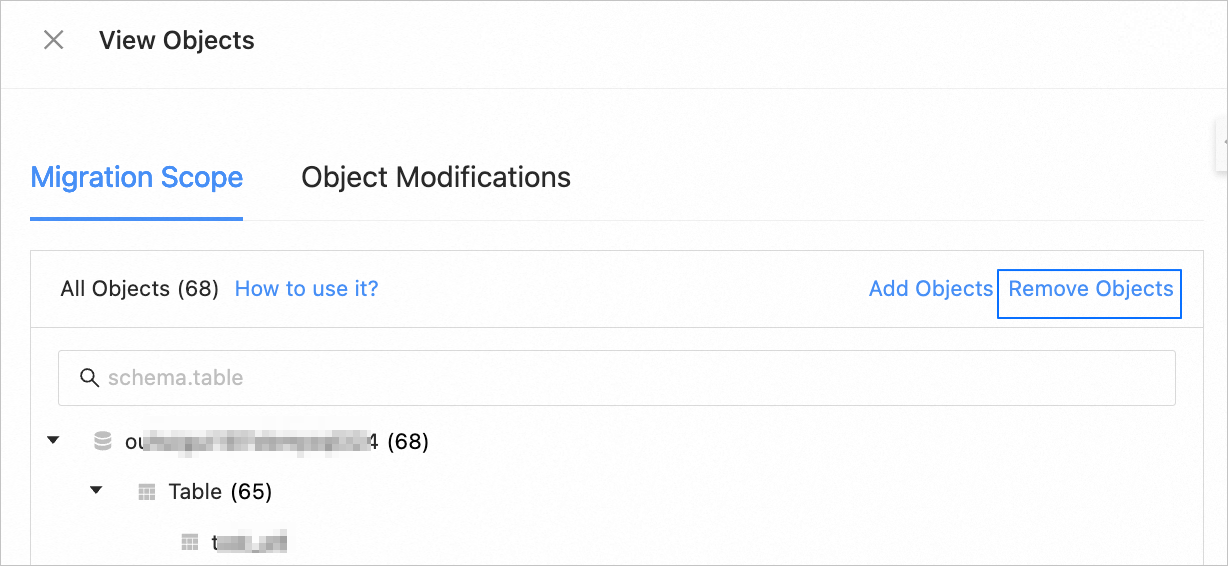
In the Remove Objects dialog box, hover over a migration object that you want to remove in the Target Object section on the right and click Remove.
In the Remove Objects dialog box, click Remove.
In the confirmation dialog box that appears, confirm the synchronization object to remove and click OK.
If the task is in the Paused, Failed, or Running state, after you click OK, the synchronization object is immediately removed from the target database.
ImportantA removed synchronization object cannot be recovered. Proceed with caution.
The final result of the object removal operation is either succeeded or failed for all synchronization objects.
When an object removal operation begins, the corresponding record is generated. To view the details of the record, click View Objects on the details page of the task and then click the Object Modifications tab.

The status of an object removal record can be Pending, Canceled, Modifying, Succeeded, or Failed. The operations that you can perform on an object removal record and the status of the original data synchronization task vary with the status of the object removal record.
Status of an object removal record
Supported operation
Status of the original task
Pending
View details and cancel the removal.
Running
Canceled
None
Running
Modifying
View details.
Modifying
Succeeded
View details.
Running
Failed
View details and retry the removal.
You can also click View Causes to go to the task details page and view the failure causes.
Modifying
Modify the filter conditions for migration objects
You can modify the SQL conditions to filter data for migration objects selected by using the Specify Objects option when a data migration task is running.
On the details page of the target task, click View Objects in the upper-right corner.

In the View Objects dialog box, click the Migration Scope tab, expand the target database, hover over the target object, and click Settings.
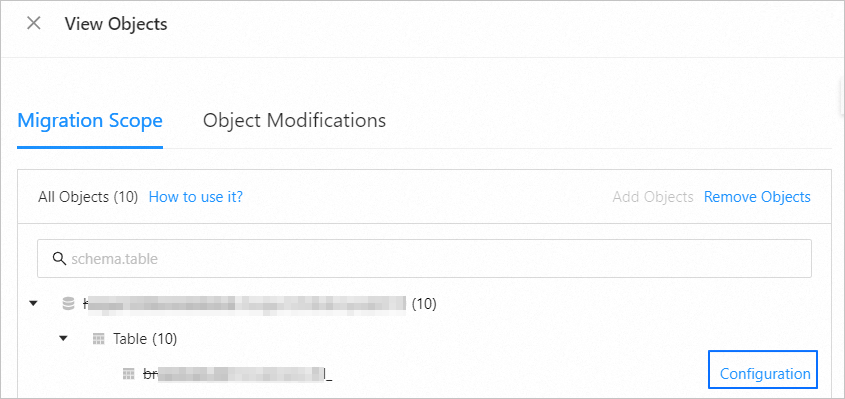
In the Row Filters section of the Settings dialog box, specify a standard SQL WHERE clause to configure or modify row filters. For more information, see Use SQL conditions to filter data.
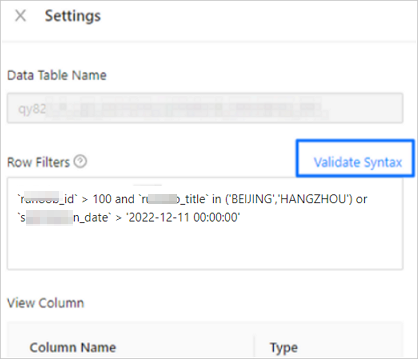
Click Validate Syntax.
After the validation succeeds, click OK in the Settings dialog box.
In the dialog box that appears, click Apply to apply the modification to the object.
On the Object Modifications tab, view the modification progress.
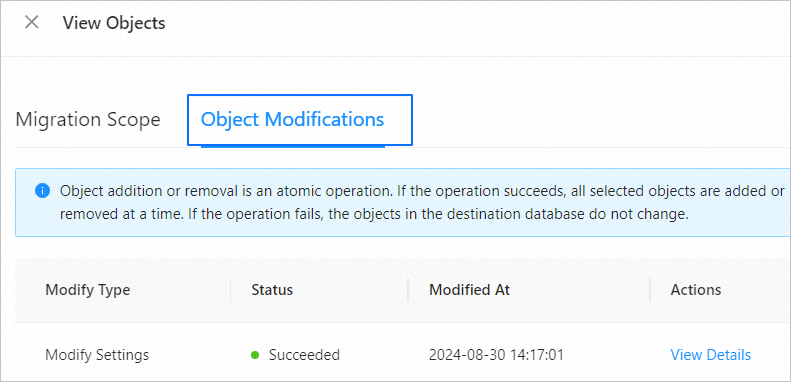
You can also click View Details to go to the Modify Setting Details page, hover over the target data table, and click View Settings to view the modified row filters.